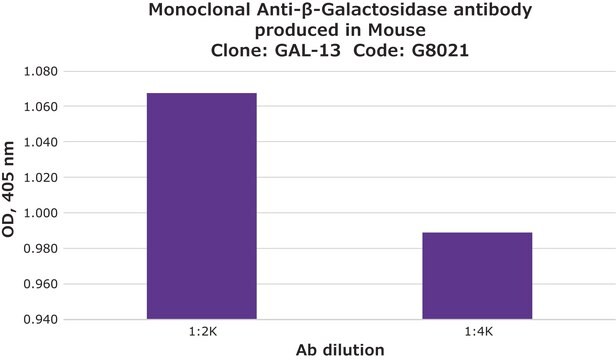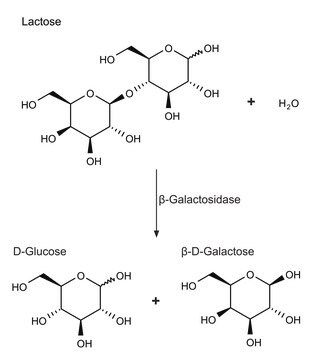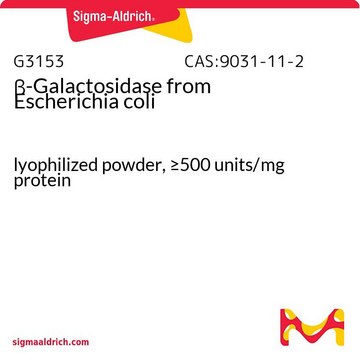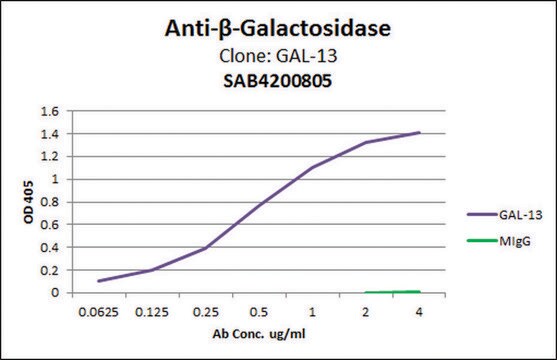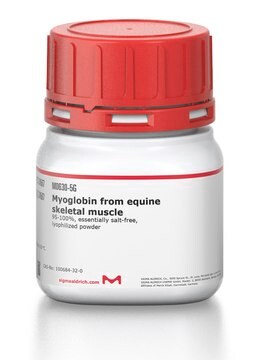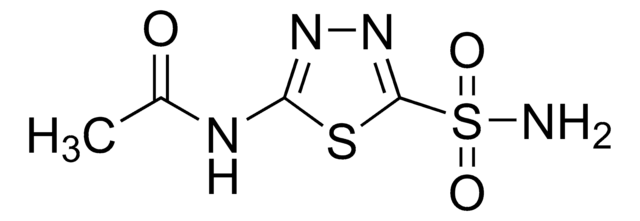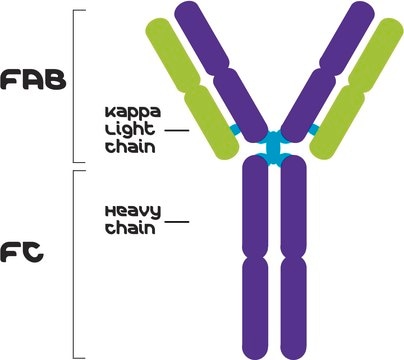G6282
Monoclonal Anti-β-Galactosidase antibody produced in mouse
clone GAL-40, ascites fluid
Synonym(s):
Mouse Anti-beta-Galactosidase
Sign Into View Organizational & Contract Pricing
All Photos(1)
About This Item
Recommended Products
biological source
mouse
Quality Level
conjugate
unconjugated
antibody form
ascites fluid
antibody product type
primary antibodies
clone
GAL-40, monoclonal
contains
15 mM sodium azide
species reactivity
bacteria
technique(s)
dot blot: suitable using soluble β-galactosidase
immunocytochemistry: suitable
western blot: 1:1,000 using denatured-reduced Escherichia coli β-galactosidase
isotype
IgM
shipped in
dry ice
storage temp.
−20°C
target post-translational modification
unmodified
General description
β-Galactosidase is coded by the LacZ gene which helps to transform lactose into galactose.
β-galactosidase is a ~465 kDa tetrameric protein. Eukaryotic genes are usually cloned into E.coli β-galactosidase (lacZ) gene that results in a fusion hybrid of the desired gene product with the β-galactosidase enzyme . As the amount of the desired gene product in these cloned vector systems corresponds to the amount of β-galactosidase, enzyme assays for β-galactosidase can be utilized to detect the required gene product . Monoclonal anti-β-galactosidase antibodies are specific for β-galactosidase in E.coli and enable the analysis of β-galactosidase fusion proteins encoded by cloned vector systems.
Specificity
The antibody may be used for detection of β-galactosidase expressed by the E. coli lacZ gene encoded in many cloned gene sequences; serves as an indicator for fusion proteins encoded by an inserted DNA sequence.
Immunogen
β-D-galactosidase from E. coli
Application
Monoclonal Anti-β-Galactosidase antibody produced in mouse has been used for western blotting.
Monoclonal anti-β-galactosidase antibodies may be used in dot blot (using soluble β-galactosidase), western blot (at a dilution of 1:1,000, using denatured-reduced Escherichia coli β-galactosidase) and immunocytochemistry. This antibody may also be used for immunochemical assays such as ELISA, immunoblot and immunohistochemistry by using the stepwise procedure or by the preparation of β-galactosidase anti-β galactosidase (BBAG) complex. Additionally, this product is suitable for the detection and purification of recombinant fusion proteins encoded by cloning vectors containing the β-galactosidase gene. Monoclonal anti-β-galactosidase antibody is also used for the immunoenzymatic staining of bone marrow and blood smears, and tissue sections.
Biochem/physiol Actions
β-galactosidase catalyses the hydrolysis of lactose to form glucose and galactose. It serves as a reporter enzyme in a number of analysis such as studying the regulation of gene expression, protein function and structure determination, and examining of target gene expression. β-galactosidase is also known to yield coloured products by acting on several substrates. Thus, it is prefered as a reporter enzyme in applications involving gene expression regulation, analysis of protein function/structure, and target gene expression.
Disclaimer
Unless otherwise stated in our catalog or other company documentation accompanying the product(s), our products are intended for research use only and are not to be used for any other purpose, which includes but is not limited to, unauthorized commercial uses, in vitro diagnostic uses, ex vivo or in vivo therapeutic uses or any type of consumption or application to humans or animals.
Not finding the right product?
Try our Product Selector Tool.
Storage Class Code
10 - Combustible liquids
WGK
nwg
Flash Point(F)
Not applicable
Flash Point(C)
Not applicable
Choose from one of the most recent versions:
Already Own This Product?
Find documentation for the products that you have recently purchased in the Document Library.
Customers Also Viewed
J M Brackett et al.
Journal of immunological methods, 200(1-2), 39-46 (1997-01-15)
A rapid, specific, perfusion immunoassay for active anti-HBsAg monoclonal IgM is described. The immunoassay requires less than 3.5 min per sample. The precision was found to be 3.6% at an IgM concentration of 17 microg/ml. A detection limit of 1
Structure of ?-galactosidase at 3.2-? resolution obtained by cryo-electron microscopy
Bartesaghi A
Proceedings of the National Academy of Sciences of the USA, 111(32), 11709?11714-11709?11714 (2014)
Ingrid Poernbacher et al.
Nature communications, 9(1), 4675-4675 (2018-11-09)
Disruption of epithelial integrity contributes to chronic inflammatory disorders through persistent activation of stress signalling. Here we uncover a mechanism whereby disruption of apico-basal polarity promotes stress signalling. We show that depletion of Scribbled (Scrib), a baso-lateral determinant, causes epithelial
María Dolores Juárez-Rodríguez et al.
Infection and immunity, 80(2), 798-814 (2011-12-07)
Tuberculosis remains a global health threat, and there is dire need to develop a vaccine that is safe and efficacious and confers long-lasting protection. In this study, we constructed recombinant attenuated Salmonella vaccine (RASV) strains with plasmids expressing fusion proteins
Lorena Betancor et al.
Biotechnology and bioengineering, 99(2), 261-267 (2007-07-13)
Many alternative strategies to immobilize and stabilize enzymes have been investigated in recent years for applications in biosensors. The entrapment of enzymes within silica-based nanospheres formed through silicification reactions provides high loading capacities for enzyme immobilization, resulting in high volumetric
Our team of scientists has experience in all areas of research including Life Science, Material Science, Chemical Synthesis, Chromatography, Analytical and many others.
Contact Technical Service